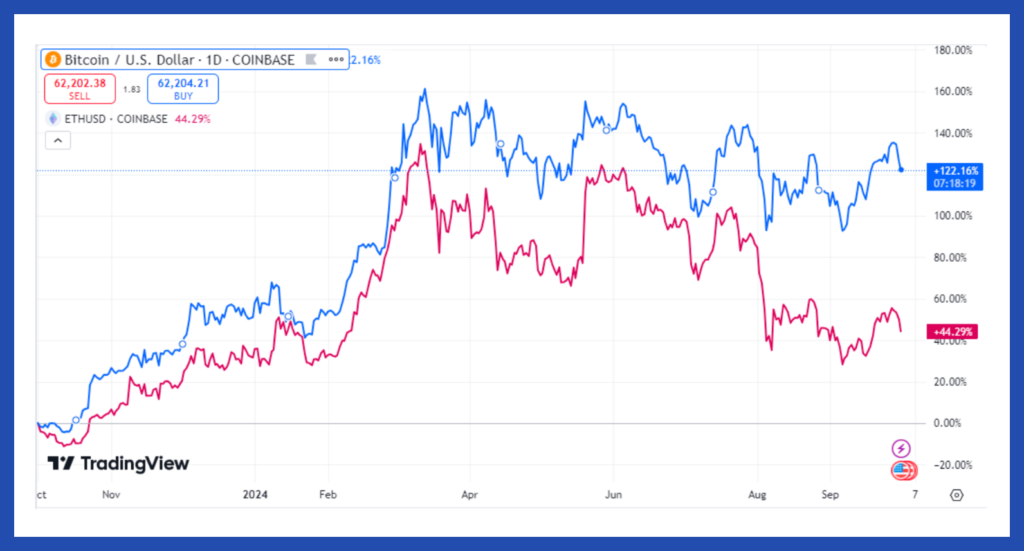Is ethereum being left behind?
As this chart shows, ethereum (ETH)—the second-largest cryptocurrency in terms of market cap—has lagged bitcoin (BTC) in investment returns over the past year. The blue line is BTC and the red line is ETH. (As of 12 p.m. EST on Oct. 1, 2024.)

Over the past year, BTC has gained about 122%, whereas ETH has gained only about 45%. Hang on—both are amazing one-year gains. However, ETH has been left behind comparatively. Here are two reasons why:
- New bull market: Usually, in a new crypto bull market—like the one that began in January 2024—BTC leads the way, in much the same way that large blue-chip stocks lead the charge in a new bull market for stocks. So, BTC’s outperformance is to be expected right now. There’s no obvious reason for ETH investors to panic (at least, not yet).
- BTC spot ETFs: In January 2024, the U.S. Securities and Exchange Commission (SEC) approved spot BTC exchange-traded funds (ETFs) for the first time. This opened the floodgates for institutional investors and large individual investors in the U.S. to gain exposure to crypto without buying it directly. True, Canada was the first country to approve BTC and ETH spot ETFs, starting in 2021 but the big market-moving money comes from the U.S. Since BTC ETFs got the nod from the SEC first—followed by ETH ETFs six months later—BTC saw more money flowing in, and earlier, compared to ETH.
How will rate cuts affect crypto?
The U.S. Federal Reserve (Fed) lowered interest rates by 50 basis points in September. And more cuts are likely to come. This is significant for bitcoin and crypto.
TLDR: when the U.S. Fed lowers interest rates, it’s essentially adding dollars into the system by reducing the cost of borrowing. The more dollars there are sloshing around in the economy, the less each of those dollars is worth. Consequently, asset prices rise—including stocks, real estate and crypto.
Think of it this way: if the number of Gucci bags in the world doubled tomorrow, each of those bags would be worth less than they are today. In other words, each Gucci bag would have been devalued. It’s the same with money.
When there’s a lot of money in the economy, people don’t want to hold cash, because of its devaluation. Instead, they’d rather hold growth assets such as stocks, real estate, gold and—yes, you guessed it—cryptocurrencies. In fact, the devaluation of the U.S. dollar is one of the strongest narratives in support of investing in bitcoin.
The chart below was shared on x.com (formerly Twitter) on Sept. 16, 2024, by Raoul Pal—author of the investment newsletter “Global Macro Investor.” It shows the close relationship between the anticipated global money supply (Global M2 10-week lead) and the price of BTC.
Federal Reserve rate cuts often lead to a rise in the money supply. So, the market is anticipating a rise in M2. If the price of BTC continues to resemble the moves in Global M2, we could be in for a sharp rise in BTC. That’s a big “if,” though. No chart can predict the future, so investors should not make decisions solely based on this (or any other) chart.
1/ Close, very close.
1/ Global M2 vs BTC pic.twitter.com/VWxHHYk0ki
— Raoul Pal (@RaoulGMI) September 16, 2024
The evolving regulatory landscape and increased institutional adoption are positive signs for crypto in Canada. Sure, some exchanges may exit due to tighter regulation, but many more are aligning themselves with securities laws. This makes crypto investing safer for Canadians.


